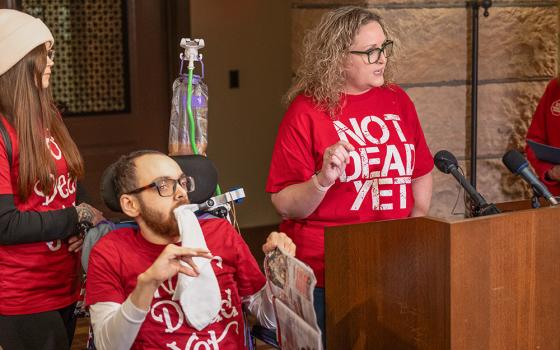 It's winter coat weather in northwest Ohio, but Sr. Jeremias Stinson's tomatoes are doing just fine. So are her broccoli, dill, beets, cabbage, lettuce, spinach and carrots.
It's winter coat weather in northwest Ohio, but Sr. Jeremias Stinson's tomatoes are doing just fine. So are her broccoli, dill, beets, cabbage, lettuce, spinach and carrots.
Stinson's veggies are thriving because they live inside a warm snug plastic greenhouse -- a polyhouse. The polyhouse makes it possible for Stinson and her food-growing colleague, Sr. Grace Ellen Urban, to maintain a year-round garden.
For the last three years, their all-seasons bounty has gone to the Helping Hands of St. Louis Parish soup kitchen to provide nutritious soups, stews and salads for hungry people living on Toledo's northeast side. Since 1992, Stinson and Urban, Sisters of St. Francis of Sylvania, have maintained a 4,500-square-foot garden and an apple orchard to help support St. Louis' daily meal ministry.
The dream of adding on a year-round operation began germinating in their hearts a little more than four years ago.
"Hunger is a 12-month problem, but here in Ohio, the freeze hits in October and nothing grows till summer," Stinson said.
Paul Cook, Helping Hands director, said the sisters' donations are significant to St. Louis' impoverished guests.
"When you're living on $1,400 a month, the money doesn't stretch far enough to buy fresh tomatoes, lettuce and apples," he said.
To see what could be done so St. Louis' guests could enjoy fresh produce all year, Stinson went on a fact-finding mission. For advice, she contacted her alma mater, Cornell University, where she earned a degree in woodland management. She also checked with local greenhouses. The perfect solution came to light: She and Urban needed to build a polyhouse.
A polyhouse mocks Mother Nature, Stinson explained: "You have to maintain a growing situation."
As the sisters discovered, this means maintaining temperature control at 70 degrees. It means pollinating with an artist's brush or fans.
The sisters had an abundance of help. One friend donated $3,000 -- the cost of purchasing the polyhouse from a local greenhouse supplier. More friends and volunteers helped set up the Quonset hut, which measures 20 feet by 48 feet, using two layers of 4-millimeter plastic.

Since circulation and ventilation are also essential factors, the air temperature needs to stay in the 70- to 80-degree range throughout the entire structure. Fans move the air around so the temperature stays constant. When the temperature gets above 80 degrees, a ventilation fan comes to the rescue. When the sun doesn't shine, a hot-water tank supplements the solar panels to make sure that the water heating the ground is always at 70 degrees. On cloudy days, a gas heater monitors the temperature.
To make sure everything mechanical is running smoothly and to tend their crops, the sisters pay daily visits to the polyhouse.
"Sometimes, we're there even before morning Mass," Urban said.
Their vigilance and dedication have paid off. In 2011, the sisters harvested 408 pounds of tomatoes from 18 plants during a growing season that extended from December through August. Their year-round growing plan has been recognized by the U.S. Department of Agriculture, according to the Sylvania Franciscan website.
Last summer, the sisters participated in an interfaith harvest celebration sponsored by the Multifaith Council of NW Ohio, an organization that encourages all churches, mosques and temples to plant gardens. There, they exchanged ideas with local food banks, rain garden initiatives and growers from Toledo's 30 local church gardens.
Currently, they are networking with local educators as well as commercial farmers who want to devote some of their crop growing to polyhouse technology.
The year-round garden is just one of the sisters' many duties. They also are in charge of environmental stewardship, shrines and woodland management for the Sisters of St. Francis of Sylvania headquarters. Part-time employees, Boy Scout troops and other volunteers help make it all possible.
Getting into gardening was natural for both sisters. Stinson's mom was Irish and her dad came from an Iroquois background.
"I always was an outdoor person," she said.
Urban's parents had a Victory garden during World War II, so planting, weeding and "helping to eat the harvest" was part of her growing-up experience. When she became a sister, Dorothy Day's example of caring for the poor was a focal point of her spirituality. She served as a classroom teacher and activities coordinator for her community's retirement center before joining Stinson in environmental ministry.
"I am always overwhelmed at the idea of putting seeds in a pot and watching them grow," Urban said. "This is God working, and all I can say is 'Thank you.'"
In spite of the joy they both experience from working in their gardens, the sisters are often saddened by the prospect of global warming, Urban said.
"It's just devastating to hear some of the stories that are happening, especially in Alaska, where there's been a 20-degree temperature change," she said.
Everyone needs to take some personal responsibility for their actions, the sister noted, "but we have to have some help from the government, too."




